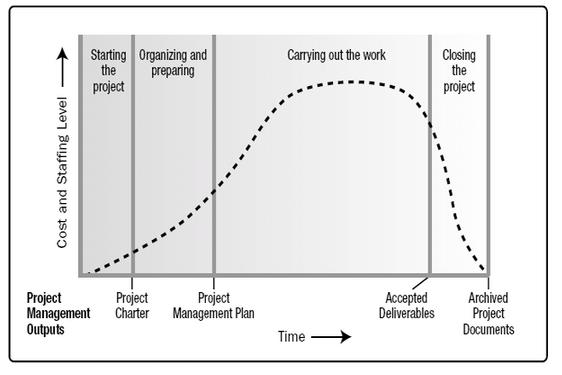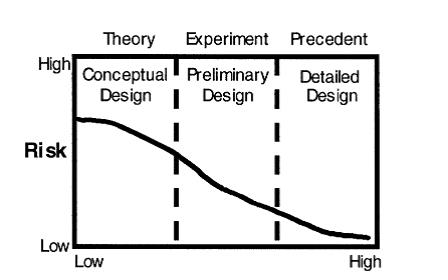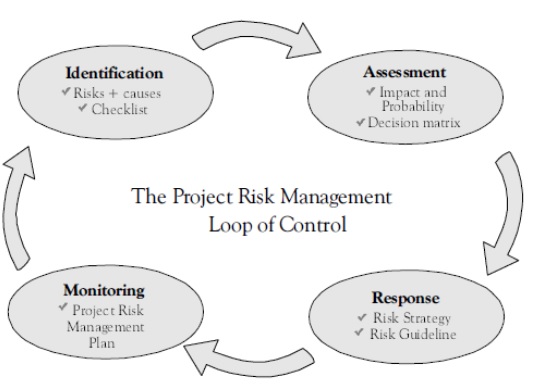The FMEA method in project risk management
Every project faces uncertainties all along its life cycle. Dealing with risks is then a fundamental aspect for a successful project management: uncertainties can affect the possible outcomes and project effectiveness The risk management's objective is to assure uncertainty does not affect the project goals. This article aims to show how
The concept of loop of control in risk management is a comprehensive model consisting of applicable methods, implying a dynamic and countinous model. The loop of control is built upon 4 phases: individuation, assessment, controlling and monitoring.
Contents |
FMEA in project life cycle
project life cycle
The project Management Institute (PMI) defines a project as “a temporary endeavour undertaken to create a unique product, service, or result. The temporary nature of projects indicates that a project has a definite beginning and end. The end is reached when the project's objectives have been achieved or when the project is terminated because its objectives will not or cannot be met, or when the need for the project no longer exists”.
Every project passes through a series of phases all along its life, from the start to the closure: all these phases represent the project life cycle. While every project life cycle is determined or shaped by the specific nature, industry and technology employed by the specific organization, all projects can be mapped to the following generic life cycle structure[2]:
- Starting the project,
- Organizing and preparing,
- Carrying out the project work
- Closing the project
In this article, the specific case of new product development is analysed. New product development (NPD) is the process by which an organization uses its resources and capabilities to create a new product or improve an existing one[4]. Product development is seen as “among the essential processes for success, survival, and renewal of organizations, particularly for firms in either fast-paced or competitive markets”)[10]. A key challenge faced by new product development projects is how to acquire knowledge and manage sources of uncertainty in order to reduce the risk of failure of either the project or the resulting product[4]. In order to take into account this aspect, the product design phases should be considered. PD processes are unlike typical business and production processes in several ways. Instead of doing exactly the same thing over and over, PD seeks to create a design that has not existed before[7]. The goal of PD is approached by producing useful information that reduces uncertainty and risk[7]. As the graph shows, the risk are higher at the beginning of the product development, precisely in the conceptual design phase. Especially with novel products, designers learn much along the way about what will and will not work[8].
Project risk management
As the definition of project above explains, a project can be either a success or a failure since the project goals cannot be achieved. Even though the success of projects highly affects the company’s business performance, many of them fails or presents delays due to inefficient management of project risk[5]. Every project faces uncertainties all along its life cycle and, by nature, product innovation involves considerable risks. The PMBOK guide (project management body of knowledge guide) defines the Project Risk Management as including the processes of conducting risk management planning, identification, analysis, response planning, and controlling risk on a project. Risks “can never be fully eliminated, but can be effectively managed to mitigate the impacts to the achievement of a project’s goals”[1]. In a highly competitive environment, management must deal effectively with these risks if the company wants to succeed. “Risk and uncertainty are greatest at the start of the project. These factors decrease over the life of the project as decisions are reached and as deliverables are accepted, while the ability to influence the final characteristics of the project's product, without significantly impacting cost, is highest at the start of the project and decreases as the project progresses towards completion”[2] Early detection of contingencies is critically important for managing and minimizing any negative impact on project performance[3]. Then, identifying risk factor as early as possible in the project development involves considerable improvements in the overall performance. The product can “fail” due to intrinsic problems (e.g. does not meet performance, reliability, or safety requirements in the environment for which it was designed) or extrinsic problems (e.g. flops in the market, changes in regulations), while the project can “fail” by violating constraints (e.g. late, over budget), not delivering the product, or being beaten by the competition[4]. Furthermore, risk does not affect all projects equally but depends on the effectiveness of collective managerial actions dealing with specific contingencies[3]. Hence, to be successful, an organization should be committed to address risk management proactively and consistently throughout the project[2]. Risks can only be prevented by identifying their sources and managing them systematically[9]. By systematically, it means that the risk management phases (identification, assessment, response and monitoring) should be performed continuously end especially each time a project milestone is achieved. The PRM Loop of Control is a comprehensive model consisting of simple and applicable methods (Elkjaer, 1998). The PRM Loop of Control illustrates a dynamic and continuous process: it is a process where risks are continuously reassessed until they are prevented, reduced or accepted[9].
FMEA in project life cycle
The Failure Modes and Effects Analysis (FMEA) can be described as a systemized group of activities intended to :
- Recognize and evaluate the potential failure of a product/process and its effects
- Identify actions which could eliminate or reduce the chance of the potential failure occurring
- Document the process.
FMEA is then a systematic technique of identifying, analyzing and preventing product and process problems before they occur[11]. “FMEA is one of the most widespread methods used in NPD to aid in determining priorities for technical risks in the management process by identifying project weak points, and as a consequence, optimising the use of NPD resources, mostly during the testing phase”[12][13]. Hence, it is very important to consider risk management as a support for the decision-making process[5]. The FMEA as a proactive tool should be performed over the entire life cycle of the project according to the vision of risk management as a continuous and dynamic process. FMECA is usually performed during the conceptual and initial design phases of the system in order to assure that all potential failure modes have been considered and the proper provisions have been made to eliminate these failures.
Throughout the product development phases, design decisions are made within the context of a flow of decisions[4], which implies that knowledge over the product, problems, uncertainties, assumption and the relationships between them can change significantly. The purpose of FMEA is to examine possible failure modes and determine the impact of these failures on the product (Design FMEA - DFMEA) and process (Process FMEA - PFMEA)[6]:
- DFMEA is used to analyze product designs before they are released to production. It focuses on potential failure modes associated with the functions of the product and caused by design deficiencies;
- PFMEA is used to analyze the new or existing processes. It focuses on the potential failure modes associated with both the process safety /effectiveness/efficiency, and problems with the functions of a product caused by the problems in the process.
Model description
FMEA is an analytical methodology used to ensure that potential problems have been condìsidered and adressed throughout the product development cycle. - qualitative risk analysis
FMEA prerequisites
System structure analysis
FMEA worksheet
Columns explanations
Risk ranking
Team review
Corrective actions
Limitations
Conclusion
References
- [1] M.W. Cohen, G.R. Palmer, 2004, "Project Risk Identification and Management", AACE international transactions
- [2] Project Management Institute, 2013, "A guide to the project management body of knowledge", 5th edition
- [3] H. Thamhain, 2013, "Managing Risks in Complex Projects", project management journal
- [4] L.P. Cooper, 2003, "A research agenda to reduce risk in new product development through knowledge management: a practitioner perspective", Elsevier, Journal of engineering and technology management
- [5] A. Segismundo, P.A. Cauchik Miguel , 2008, "Failure mode and effects analysis (FMEA) in the context of risk management in new product development: A case study in an automotive company", International Journal of Quality & Reliability Management
- [6] Z.Bluvband, P. Grabov, 2009, "Failure analysis of FMEA", IEEE
- [7] T.R. Browning, J.J.D. Deyst, S.D. Eppinger, 2002 , "Adding Value in Product Development by Creating
Information and Reducing Risk", IEEE transaction on Engineering Management
- [8] P. Nightingale, “The product-process-organization relationship in complex development projects,” Res. Policy, vol. 29, pp. 913–930, 2000.
- [9] M. Elkjaer, F. Felding, 1999, "Applied project risk management – introducing the project risk management loop of control", International project management journal, pg. 16
- [10] M. Susterova et al., 2012, "Risk management in product development processes", DAAAM international


